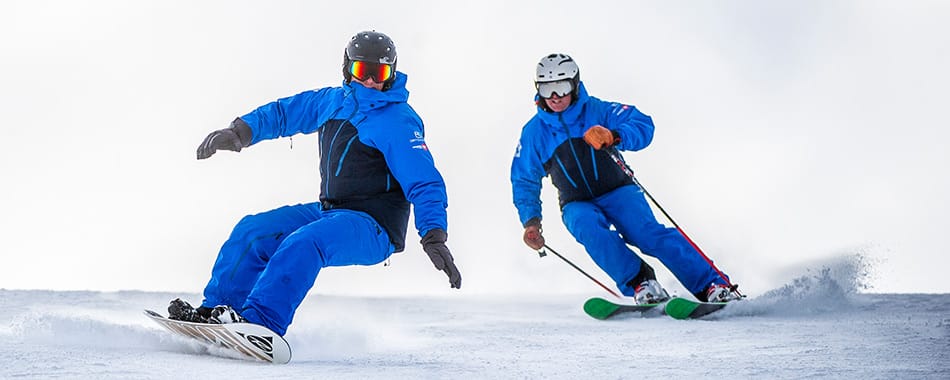Firmly in the throws of another winter season, many are still looking forward to holidaying in the mountains and seeking out that last adrenaline rush as we fly down a mountain disconnected from the stresses of office for just that moment in time.
Whilst most of us will spend hours and hours thoroughly researching resorts, flights, accommodation, equipment and so on, few of us will pause to question, “am I physically fit and prepared to spend the week skiing?”
Injuries on the mountain are sadly inevitable and the hard reality of it is that turning up unfit is one sure way to make yourself vulnerable. The old school thinking of a simple warm up and cool down being sufficient is a little passé and if you truly want to prepare yourself for some mountain action, then you’re going to have to work a little bit harder, and start earlier.
So rather than doom and gloom of mountain injuries, lets look at the positive steps you can take in preparation to become more physically robust and champion the holiday like a pro!
PRE-HOLIDAY: GET ON YA BIKE!!
For cardiovascular (CV) fitness, cycling provides a great transition through to skiing/boarding. Get yourself to a regular spin class, out on your road or mountain bike, get your heart and lungs pumping and leg muscles fired up – trust me you will reap the reward once on the mountain! If you’ve no access to a bike, power walking, jogging or swimming are also a great way to increase your CV fitness. All this enables greater muscular endurance, which means many more energetic miles on the mountain whilst delaying the inevitable “thigh burn” of fatiguing muscles.
PRE-HOLIDAY: GET STRONG!
Strength in the legs and core is key to happy, healthy, injury free skiing. Even 15-20 minutes of strength training work, 2-3 times per week will make all the difference. It really doesn’t have to be a long periods out of your day! Ideally start a few weeks before departure, but it’s never too late to get those muscles woken up!
Here are some common leg and abdominal exercises that translate well to skiing:
- Lateral jumping into deep bend
- Basic squats
- Jump squats
- Lunges – forward to back and side to side
- Abdominal bicycles
- Mountain climbers
- Plank – front and side
- Bridge
- One leg bridge with leg extension.
PRE-HOLIDAY & DURING: GET BENDY!
Flexibility is highly underrated when it comes to being ski-fit and all too often overlooked! Flexibility at the ankles, knees and hips can make achieving a great technique far easier. Working on this before your trip is great but warming up and mobilising all the joints and muscles before hitting the slopes is also vital.
You should aim to include stretches of the calf muscles, hamstrings, gluteals, quadriceps & hip flexors. Stretches can be done statically (e.g. 2 holds of 30 seconds each side) or dynamically (repeated stretching movements – no holds). I tend to favour dynamic stretching for warming up and a short sequence of static stretches after a long days skiing.
On the morning of a ski day you should incorporate functional exercises to warm up and improve joint mobility for the following joints:
- Ankles. Pedal the feet, dropping the heels low of the back of a step.
- Hips. “Open the gate/close the gate”. Open = raise knee to 90°, take out to side then lower. Close = the reverse direction.
- Pelvis. “Knee-to-chest” – Lying on your back pull one knee to chest and hold then the other.
- Low back. Lying on back bend knees up then roll to one side keeping shoulders intact with floor, creating a twist through the low back.
- Mid back. “Cat-camel” on all fours.
- Shoulders. 360 degree swings.
- Neck. “Yes, no, maybe” nodding exercise. Stretch to the end range of each motion.
Some final thoughts on avoiding injury on the mountain:
- Address any current injuries / weakness BEFORE the ski holiday. Chances are the extra demand and loads will only further stress the already weakened/damaged area. Consult your local chiropractor, osteopath or physiotherapist for guidance on optimised healing, and possible options for support during the ski holiday.
- Technique instruction is invaluable. A proficient technique is biomechanically more efficient and ultimately far healthier for your joints and muscles, so invest in some guidance with some – you won’t regret it!
- If using your own equipment, be sure to get it checked regularly or use a reputable hire company.
- Always wear suitable clothing and protective gear.
- Discuss use of supportive strapping/braces with a health professional before using on the mountain. Often friend but sometimes foe!
- Follow mountain safety guidelines & ski within your limits.
- Avoid fatigue and take frequent rests. Recognising the need to rest is so key to injury avoidance!!
- Be warey of the affects alcohol has on our physical abilities – don’t drink too much at lunch and be aware of day-after dehydration!
- If you do sustain an injury, please seek medical advice before continuing and potentially doing further long-term damage.
 For any questions on the above, don’t hesitate to contact Georgie from Chasing Lobsters, a British chiropractor, passionate health nerd and aspiring kitchen goddess!
For any questions on the above, don’t hesitate to contact Georgie from Chasing Lobsters, a British chiropractor, passionate health nerd and aspiring kitchen goddess!










